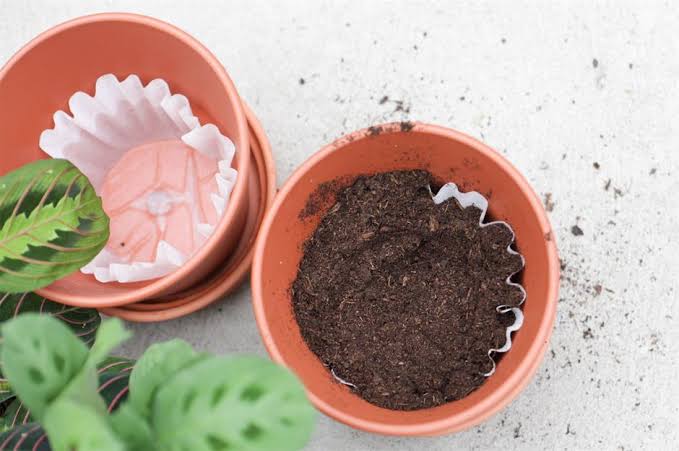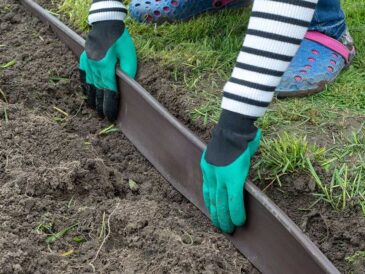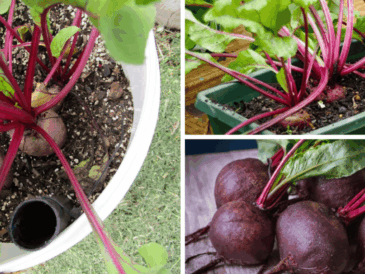It might sound unusual, but gardeners swear by this little hack – and for good reason.
A humble coffee filter can dramatically improve your plant’s health, prevent messes, and even save you from wasting expensive potting soil.
The Hidden Problem With Most Flower Pots
Almost every flower pot comes with drainage holes at the bottom – and for good reason. Those holes allow excess water to escape, preventing the soil from becoming soggy and roots from rotting.
But there’s a catch.
When you water your plants, small soil particles often wash out through those holes, along with nutrients your plant needs.
Over time, this leads to:
- Soil loss and messy surfaces under your pots
- Clogged drainage holes as roots or debris block them
- Uneven moisture retention – your pot dries too quickly in some spots
- Reduced aeration, which suffocates roots
That’s where the coffee filter trick comes in – a simple, inexpensive fix that makes a big difference.
Why a Coffee Filter Works Perfectly in Pots
A standard paper coffee filter acts like a breathable barrier. It’s designed to let water pass through easily while keeping coffee grounds in place – and it performs the exact same function in your flower pots.
When placed at the bottom of a pot, a coffee filter:
- Keeps soil in place while allowing water to drain freely
- Prevents clogging of drainage holes by fine particles or roots
- Improves water retention by slowing the outflow just enough for roots to absorb more
- Reduces mess – no more muddy puddles under your pots
It’s one of those simple household items that instantly improves your gardening experience.
The Science Behind It
Healthy potted plants depend on a balance of drainage, aeration, and moisture retention.
If water drains too slowly, roots suffocate.
If it drains too fast, soil dries out before roots can absorb enough moisture.
A coffee filter adds a thin, porous layer that creates the ideal drainage balance:
- The paper fibers act like a sieve, letting excess water flow but holding back fine soil particles.
- The filter slightly slows water movement, increasing root hydration without waterlogging.
- It helps maintain soil structure and prevents compacting, ensuring roots have oxygen to breathe.
Think of it as a tiny eco-friendly layer of protection for your pot’s ecosystem.
Step-by-Step: How to Use a Coffee Filter in a Flower Pot
It only takes a minute to set up this gardening trick – and once you try it, you’ll want to do it in every pot you own.
What You’ll Need:
- A clean flower pot with drainage holes
- 1 standard paper coffee filter (any size will work)
- Potting soil of your choice
- Optional: a few pebbles or perlite for added drainage
Step 1: Prepare the Pot
Make sure the pot is clean and that its drainage holes are unobstructed. If you’ve used it before, rinse off any mineral deposits or old soil.
Step 2: Add the Coffee Filter
Place a single coffee filter flat across the bottom of the pot, covering all drainage holes. If your pot is large, you can overlap two filters slightly or cut one to fit.
The filter should sit flush against the bottom but not fold up the sides too high – just enough to prevent soil from escaping through the holes.
Step 3: Fill With Soil
Add your potting mix on top of the filter, pressing gently to remove air pockets.
The filter will stay in place, creating an invisible layer between the soil and the drainage holes.
Step 4: Plant and Water
Plant your flowers, herbs, or houseplants as usual.
When you water them, you’ll notice clear runoff without muddy drips – and your soil level will stay consistent over time.
The Immediate Benefits You’ll Notice
Using a coffee filter in your flower pot might seem like a small change, but the effects are immediate and noticeable.
1. Cleaner Water Drainage
No more dirty water stains or streaks on your windowsills, shelves, or patio. The filter traps fine soil and organic matter, so only clear water flows out.
2. No More Soil Loss
Each watering session can wash away small bits of soil. Over weeks, that adds up – leaving roots exposed and nutrients lost. The filter locks in your soil while keeping drainage smooth.
3. Prevents Clogged Holes
Fine soil or root tips can clog drainage holes, leading to stagnant water and root rot. The coffee filter keeps debris away from the holes, allowing air and water to move freely.
4. Longer Soil Moisture Retention
Because the filter slows water drainage just slightly, your soil stays moist longer – reducing how often you need to water, especially helpful in hot or dry climates.
5. Healthier Root Growth
Roots thrive in oxygen-rich, well-drained soil. With better aeration and consistent moisture, they grow deeper, stronger, and more resilient.
6. Cleaner Gardening Indoors
For indoor gardeners, this trick is a game changer. You’ll avoid messes on furniture, shelves, and floors – making it ideal for hanging pots, windowsills, or decorative containers.
Works for Any Type of Plant or Pot
Whether you grow succulents, herbs, flowering annuals, or indoor houseplants, coffee filters work beautifully in all setups.
Great for:
- Houseplants: Keeps potting mix neat and prevents stains under pots.
- Outdoor planters: Helps in windier spots where soil can blow away.
- Seedlings and herbs: Maintains gentle moisture without overwatering.
- Hanging baskets: Reduces dripping soil onto patios or balconies.
You can even use this trick in terracotta pots, where drainage is fast, or plastic containers, which sometimes hold water too long – the filter balances both extremes.
Eco-Friendly and Cost-Effective
One of the best things about this hack is how sustainable it is.
Coffee filters are biodegradable, non-toxic, and inexpensive. You’re repurposing a simple kitchen staple to enhance your garden’s efficiency without waste or chemicals.
And if you already use coffee daily, you can give those filters a second life – even used filters (rinsed clean of grounds) work perfectly in pots.
Bonus tip: Add the used coffee grounds themselves to your compost or mix lightly into your potting soil for a nitrogen boost.
What About Other Alternatives?
You might wonder – can’t I just use rocks, gravel, or mesh instead?
Let’s compare.
| Material | Pros | Cons |
|---|---|---|
| Coffee Filter | Biodegradable, lightweight, keeps soil & water balanced | Breaks down slowly over time (replace when repotting) |
| Gravel or Rocks | Improves drainage slightly | Adds weight, doesn’t stop soil loss |
| Mesh or Screen | Reusable, effective barrier | Harder to cut or fit in round pots |
| Paper Towels or Newspaper | Similar effect, biodegradable | Breaks down faster, may clog holes |
| Fabric or Felt | Works well, reusable | More expensive than filters |
So while other materials can help, coffee filters strike the perfect balance – easy, affordable, and just the right texture for water and air flow.
Can You Use Coffee Filters in Hydroponics or Self-Watering Pots?
Yes – with slight adjustments.
In hydroponic systems, a coffee filter can act as a root support layer, keeping soil or clay pebbles from clogging water reservoirs.
In self-watering planters, the filter helps maintain consistent moisture transfer between soil and the water chamber – preventing oversaturation or mold growth.
It’s one of those small tweaks that improves function without changing design.
How Long Does It Last?
A coffee filter lasts as long as your potting cycle – usually 1–2 years before it naturally decomposes.
When you repot your plant, simply replace it with a fresh filter. The old one can be composted, as it will have partially broken down into organic matter.
This means it’s not just functional – it’s also contributing back to your garden’s ecosystem.
Common Questions About Using Coffee Filters in Pots
1. Will the filter stop drainage completely?
No. Coffee filters are porous – they let water pass easily while holding soil in place.
2. Can I use plastic coffee filters?
Stick with paper filters. Plastic mesh filters don’t biodegrade and can block water movement over time.
3. Does it attract mold or pests?
No – as long as you avoid overwatering. The filter dries with the soil and won’t encourage mold.
4. Can I use used filters with coffee residue?
Yes, but rinse out excess grounds first. Small traces of coffee add nitrogen to the soil, but too much can make it acidic.
5. Does it affect pH or nutrient levels?
Not significantly. Coffee filters are neutral and safe for all soil types and plant varieties.
Gardening doesn’t always require fancy tools or expensive solutions – sometimes, the smartest fixes are already in your kitchen.




